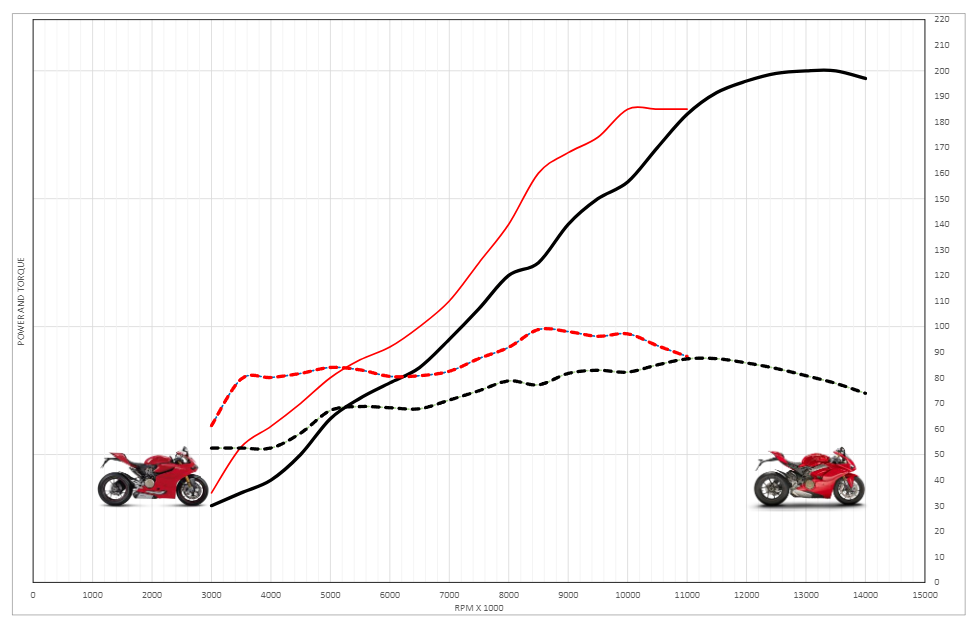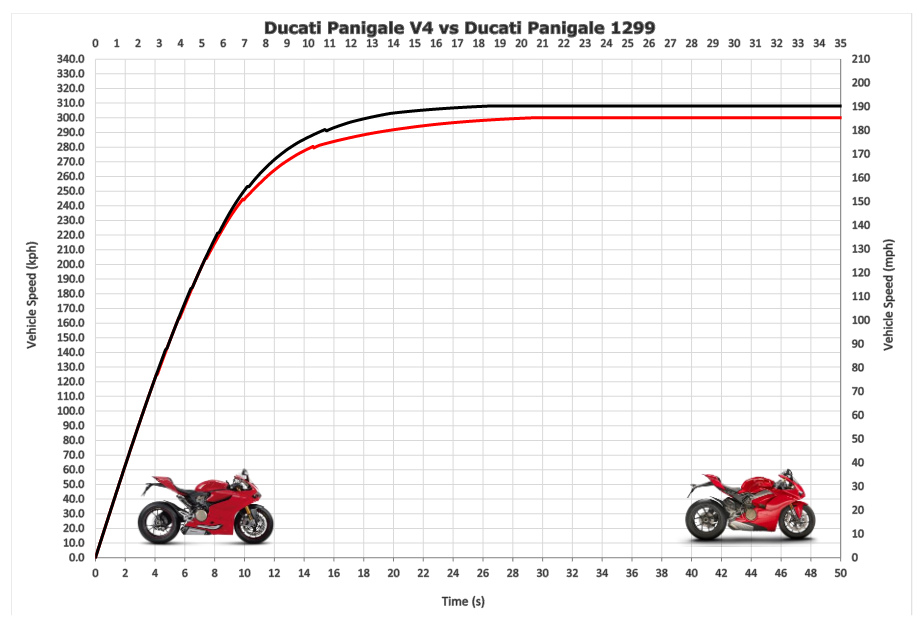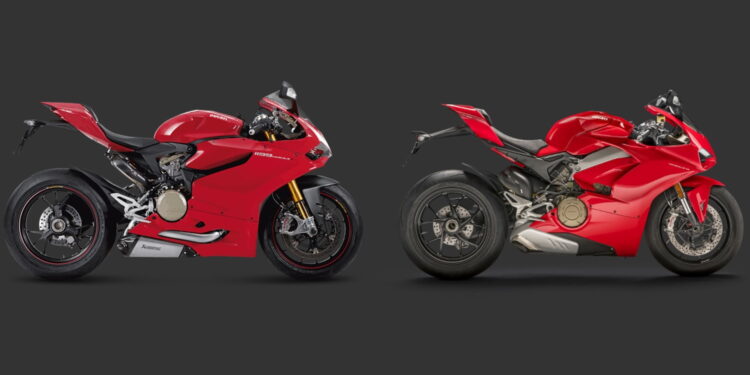Panigale V4 Vs Panigale 1299
When the Ducati Panigale V4 was announced and then subsequently launched in 2018 there were mixed reactions from Ducati fans and the motorcycling world.
Ducati Superbikes for as long as most of us can remember have pretty much always been the L2 configuration with two cylinders opposed at 90 degrees with that configuration being synonymous with the Italian marque.
It goes without saying that Ducati has also had huge amounts of success in recent history both in domestic and international production motorcycle championships.
Ducati has tallied up multiple championship wins across almost all their Superbike offerings through the years.
On the world stage, Ducati with their famous L2 configuration has won 14 World Superbike Championships and with each L2 motorcycle, they put forward to compete being a championship winner at least once.
From the gorgeous Ducati 851 piloted by Raymond Roche in 1990 to their last WSBK title with Carlos Checa aboard the monstrous 1098R back in 2011.
That is 14 world championships in only 21 years, an amazing feat for what is a small factory based outside of Bologna, Italy.
For much of this time, one could argue that Ducati always had an unfair engine capacity advantage because during that span for much of the time Ducati’s often had up to a 250 cc displacement edge.
Ducati capitalized with that 250 cc advantage during 750 4/1000 2 eras, as well as 1000 4 to 1200 2 eras that followed.
There was a period between X and X where capacities for both 2-cylinder and 3-cylinder motorcycles were the same.
On the counter, one could also argue that the smaller 4’s with their multiple-cylinder engines would have had a power advantage if the capacities of both competing configurations were the same.
This is because more cylinders for any given engine capacity will always have the theoretical ability to rev higher and inadvertently, as a result, make more power.
Ensuring that big 500 cc cylinders can rev hard and fast enough to make competitive power was an immensely difficult technical challenge.
Right at the end of the Ducati 999 L2 development cycle, and before it was replaced by the 1198 cc 1098R, the 999 was rumoured to be making its power at approximately 13,000 rpm and more than 190 hp.
For an L2 with 500 cc pistons was an amazing engineering feat at the time.
Later on and in the era of the 1098R and Panigale 1199R, this cylinder size went up further to 599 cc in the pursuit of more power to counter the new rules that allowed the 4s to go from 750 to 1000 cc.
The Japanese 4s during this time already had a good few years competing at 1000 cc and with the introduction of new production models, in race trim, they started to make more than 200 hp in the mid to late 2000s.
As each manufacturer introduced newer models, even stock from the dealership, litre 4s were making the kind of power that factory Superbikes were making less than a decade before.
At end of life or the 1198 cc 1098R, the 4-cylinder 1000 cc WSBK factory Superbikes were making more than 220 hp despite many tuning regulations hampering their actual potential.
2011 was the last time Ducati won a world superbike championship, but they didn’t know that at the time.
2012 was the last time we saw the 1198 cc 1098R factory Superbike, while Max Biaggi won the title on the impressive and super-fast Aprilia RSV4 which is a 1000 cc 65-degree V4.
At this point in time, despite its 1198 motor, the big Duke was 10-15 km/h down on some of the tracks with the longest straights such as Monza.
Biaggi’s Aprilia V4 exceeded 330 km/h at Monza.
Only a few years before, the 1000 cc L2 Ducati’s were struggling to it 300 km/h on the same track.
As the Ducati1098 started to become a little long in the tooth and with competitor fours becoming ever more capable and competitive.
For Ducati to continue and build upon their great success nationally and more importantly internationally in production class racing, and then on right into and through the 2010s for a prosperous future.
Ducati took their L2 platform to the extreme with the introduction of the Panigale 1199.
On paper, this new Ducati appeared to be a winner even without turning a wheel. The stock bike alone made a claimed 195 hp at the crank and weighed in at 166 kg dry.
At the time, the new Panigale 1199 had the highest power-to-weight ratio of any production vehicle. It had ‘winner’ and ‘racing dominance’ written all over it.
And of course, this was not the base that Ducati would race with, that would be reserved for the Panigale 1199R.
The 1199R is a homologated special production version of the base 1199 with all the goodies and a more competitive platform from which Ducati was to mount their racing assault.
Despite looking like the new Panigale will carry on the Ducati ultra-competitiveness and dominance on the world stage.
Unfortunately, it did not pan out as expected.
From 2011 until the 1199’s last race before being superseded, Ducati quite surprisingly failed to secure a world championship at the top level for what is coming close to a decade now.
This is a stark departure from the 14 world championships achieved by Ducati during a twenty-one-year period prior to 2011.
The Panigale did achieve some success in some domestic championships as well as Superstock 1000 at an international level but the machine never quite achieved what was expected from it despite its on-paper credentials.
The Panigale 1199 up until recently was the best motorcycle ever to come from the Bologna factory but it failed on the international stage. In short, we can arguably put this down to two main reasons.
Ducati’s competitors continually designed and produced more accomplished motorcycles too, and on proven platforms that had plenty more to offer as well as tried and tested conventional twin-spar aluminium frames.
The Panigale was considered by most who competed with the machine as very difficult to get the most out of.
Many hypothesized that it was partly due to its monster engine and peaky power delivery combined with the monocoque chassis design that was inspired by their Desmosedici RR MotoGP bike.
One thing to note, all previous WSBK Championship-winning Ducati from the 851,888 916, 999 and 1098 motorcycles, had their engines all cradled by the famous and sweet handling steel-trellis frame.
The designers of the new Panigale opted for a futuristic and advanced monocoque design that had more in common with an F1 car than a motorcycle.
While their L2 platform was tried and tested and multiple championship winning……The new monocoque did not have a quite distinguished Resume.
Whether it was the beastly engine and mega stiff chassis design that were the main determining factors in the Panigale’s lack of success, is still open for debate.
However, would fortunes have turned out differently for Ducati had they mounted the incredible Panigale engine to the tried and tested steel trellis frame that served Ducati so well for so long is anyone’s guess.
To keep the Ducati Panigale competitive on the road, Ducati introduced the 1299, which is a slightly larger-engine and revised version of the 1199
The Ducati Panigale 1299 was not eligible for World Superbike racing due to the motor exceeding the WSBK capacity limit for two-cylinder motorcycles, which is, and remains at 1200 cc.
Fast forward to 2018, and Ducati had decided that the L2 platform had run its course and reached its design potential, with it no longer being possible to eke out any more competitiveness.
A new direction was required to bring Ducati back to that success that they were so familiar with but had not seen since 2011 and the 1098R in the hands of Carlos Checa.
Roll-on 2018 and the Ducati Panigale V4 was born which was the first Ducati Superbike of recent times to adopt a 4-cylinder engine.
Lest us not forget forget that Ducati shocked motorcycling world with the road-going MotoGP replica Desmosedici RR back in 2008.
Ducati evidently had some experience with the V4 configuration for some time and won a MotoGP World Championship in the hands of Casey Stoner.
The V4 configuration at least in MotoGP seems to offer the best compromise for power, ergonomics and handling.
Yamaha and Suzuki are the only manufacturers not using the V4 configuration.
It is rumoured that Suzuki will be moving to the V4 platform shortly and rumours have also surfaced from time to time that Yamaha will drop their crossplane crank straight four in favour of a V4 configuration too.
This decision is likely due to Yamaha having the least powerful engine on the MotoGP grid as demonstrated by Rossi and the like achieving the lowest numbers in the speed traps for any factory MotoGP.
While Ducati has claimed only one MotoGP championship with their V4 back in 2007 they have been hugely competitive in recent years as their V4 motor has been dominant for a number of years in terms of top speed and acceleration.
It only makes sense that they will adopt what they have learnt in MotoGP and introduce it to the road.
As the dust has now settled, and the V4 is the new Ducati Superbike benchmark, how does the V4 stack up against the 1299 cc L2 model it supersedes?
Ducati opted to release an 1100 cc version of their V4 for the mass market while an eligible 1000 cc version was homologated for racing in the shape of the Panigale V4R.
There was no other reason to have a V4 at 1100 cc for the road other than that they could. An extra 100 cc over its competitors would aid a dyno chart advantage.
Also opting for 1100 cc was likely aimed at satisfying their L2 fans who were used to buckets of torque that the parting 1299 offered up that a 1000 cc V4 could not offer parity to.
The Panigale V4 generally offers up to 10 to 15 peak hp advantage over the Panigale 1299!
As the Panigale Panigale V4 engine gives away 182 cc to the 1299 Panigale, it was never going to produce comparable power and torque for the majority of the rev range.
Funnily enough, despite being a large capacity L2 the older 1199 wasn’t the torque monster it should have been due to Ducati having to chase peak hp numbers to be competitive on the road and track.
This was one of the 1199’s major criticisms but was a necessary move from Ducati.
To have a hope of making the claimed 195 horsepower the Panigale1199 had to run with a very aggressive bore and stoke configuration (short stroke).
This was done to help the engine rev and make power high up the rpm that no engine with 599 cc pistons had any right to rev too.
In road trim, this made for an overly aggressive and peaky almost two-stroke style delivery.
It also didn’t help with its peaky nature as the Panigale 1199 also had relatively high gearing (in particular the last three) which is common in big-capacity twins.
Much of these issues could be alleviated with an exhaust and tune, but still, the Panigale 1199 was never the torque monster that the longer-stroke 1198 is.
Back to the Panigale 1299, that extra 86 cc with some other minor motor tweaks added 10 hp to its peak, but also added a bit more go in the low mid, and bottom end.
The Panigale 1299 was still a peaky engine but its sheer capacity did make up for this to a degree as compared to the Panigale 1199 there is more power and torque low down in the rpm range

Ducati Panigale V4 vs Ducati Panigale 1299 Dyno
– V2 – V4
The 1299 makes more rear-wheel hp and torque right through the rev range, and that is due to its 182 cc advantage.
As the V4 is a smaller displacement engine and with that displacement divided up into 4 cylinders at 275 cc each, this enables the V4 to rev higher and ultimately produce more peak HP.
The Panigale V4 revs to a mind-boggling high 14500 rpm vs the 1299’s 11500 rpm.
Looking at the dyno alone you’d assume that the 1299 monsters the V4 if comparing in-gear roll-ons but the dyno chart does not present the whole picture as you’ll see once we take a look at in-gear thrust curves.
Both motorcycles do rev a little higher than the dyno suggests but the V4 stops making power after 14000 rpm and drops sharply.

Ducati Panigale V4 vs Ducati Panigale 1299 Thrust
– V2 – V4
Gears are a multiplier of torque, and here we see how much thrust at the wheel each motorcycle produces when their power/torque curves are fed through their gearboxes and rear wheels.
While the V4 makes less power and torque through the rev range and up to 11000 rpm, because the V4 can rev approximately 3000 rpm higher than its larger capacity sister the V4 can take advantage of substantially lower gearing.
Even if the V4 has lower gearing it does not sacrifice overall top speed or top speed in each gear because it can spin those gears faster, thanks to its higher rpm.
What this translates into for the V4 is that in the first 3 gears, it is very close between the two motorcycles in terms of in-gear acceleration.
The Panigale 1299 dominates the very bottom, while the V4 matches the 1299 in first gear and in the mid part of the gear/speed and beats it in the top.
While in second and third gear, the 1299 only has the advantage at the bottom end of the speed range in both gears, with the V4 besting the 1299 in the middle and top end. It gets much worse for the 1299 in 4th, 5th and 6th.
The V4 completely dominates the 1299 in 4th from 110 km/h upward.
The 1299 needs 5th gear to at the very least match the V4 in 6th, which it can only do under 150 km/h and briefly for a moment at 220 km/h before the V4 takes off again.
Speed in gears at 5000 rpm
| Speed at 5000 rpm | 1299 | V4 |
| 1st | 33.7 mph | 31.4 mph |
| 2nd | 44.3 mph | 40.3 mph |
| 3rd | 55.4 mph | 49.1 mph |
| 4th | 66.5 mph | 56 mph |
| 5th | 76.2 mph | 62.5 mph |
| 6th | 86.2 mph | 68.2 mph |
What this means on the road is for the 1299 to stay with the V4, gear choice is more important, especially so in 4th 5th and 6th.
Whether we like it or not the V4 has a more flexible real-world engine performance over the 1299 due to the 1299’s handicap of longer gearing due to it being a lower revving motor and running comparatively longer gearing.
The 1299’s massive torque advantage is not enough to make up for its long gearing. This could of course be remedied to a degree without sacrificing top speed, as the 1299 stock can’t hit its limiter in top gear.
Equally the same could be said for the V4 as both have little leeway to opt for lower gearing while not hindering their top speed potential.
Ducati Panigale V4 vs Ducati Panigale 1299 Acceleration
As a rule, it is peak power that gets you that top speed and outright acceleration. With close to 20 hp more at the wheels versus the 1299, ultimately the V4 not only accelerates faster but also goes on to peak at a higher top speed.
Acceleration is close between the two.
Most current litre superbikes all accelerate pretty much similarly up to 140-150 mph as they all share the same issue of translating the full arsenal of their obscene power due to wheelies and traction issues.
Generally, things settle down 3rd/4th where the minor power/torque differences between these machines can start to assert themselves.
In the case of the 1299 and V4, we can see that the V4 starts to convincingly edge ahead of the 1299 in the north end of fourth gear!
When the Ducati 1299 hooks into fifth; at which point its acceleration starts to flatten off while the V4 keeps charging forward.
0-60 mph and even quarter mile times are pretty worthless when comparing current litre Superbike as most of them are all around the high 9’s or low 10’s, with terminal speeds all a few mph apart.
0-180 mph is the most telling benchmark and is a speed where you can see some actual measurable differences between litre bikes though they are still awfully close.
The V4 is the fastest motorcycle we have tested to date, hitting this magic number in 14.5 seconds and beating our previous fastest the 2015 Yamaha YZF-R1, with the 1299 4.6 seconds slower at 18.6.
Despite the V4 in most real-world situations being more accelerative than the 1299, as well as beating it in terms of outright acceleration, this performance difference would only be noticeable on track.
On the road you would see differences above 150 mph and on the very straightest of roads.
The differences on the street unless you do roll races like 650ib are inconsequential. They both will melt your face and bend space and time.

Panigale 1299 vs Panigale V4 vs Acceleration and top speed
– V2 – V4
| 1299 Vs V4 Acceleration | ||
| MPH | 1299 | V4 |
| 0-10 mph | 0.51 | 0.50 |
| 0-20 mph | 1.01 | 1.01 |
| 0-30 mph | 1.53 | 1.52 |
| 0-40 mph | 2.05 | 2.04 |
| 0-50 mph | 2.57 | 2.56 |
| 0-60 mph | 3.11 | 3.05 |
| 0-70 mph | 3.66 | 3.65 |
| 0-80 mph | 4.29 | 4.21 |
| 0-90 mph | 4.88 | 4.85 |
| 0-100 mph | 5.49 | 5.46 |
| 0-110 mph | 6.20 | 6.10 |
| 0-120 mph | 6.88 | 6.83 |
| 0-130 mph | 7.71 | 7.54 |
| 0-140 mph | 8.59 | 8.39 |
| 0-150 mph | 9.62 | 9.31 |
| 0-160 mph | 11.17 | 10.59 |
| 0-170 mph | 13.16 | 12.33 |
| 0-180 mph | 18.11 | 14.85 |
| 0-190 mph | n/a | 21.52 |
| 0-200 mph | n/a | n/a |
| 60-120 mph | 3.77 | 3.73 |
| 100-160 mph | 5.67 | 5.12 |
| SS/QM | 10.17/153 mph | 10.11/156 mph |
| SS/KM | 18.01/180 mph | 17.77/186 mph |
| SS/Mile | 25.34/184 mph | 24.85/192 mph |
| Top Speed | 187 mph | 192.6 mph |




















